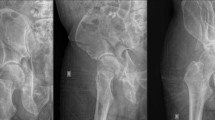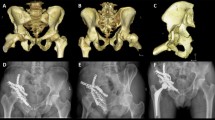Abstract
The aim of this review is to summarise the current concepts in the management of acetabular fractures in the elderly population. A literature review of the evidence regarding the management of elderly acetabular fractures was performed utilising PubMed and Ovid. The predominant causes and fracture patterns of acetabular fractures are changing as populations age. Consequently, the operative management has had to change also. Judet and LeTournel did not offer operative treatment to any patients older than sixty. However, in the present time, according to the German Pelvic Registry, over half the patients aged sixty or over, sustaining acetabular fractures underwent operative fixation. We find that the increasing age of the population raises particular challenges for the operating surgeon. Postoperative rehabilitation should be focused on early mobilisation. More research needs to be focussed on standardised treatment protocols and long-term outcomes for this cohort of patients.









Similar content being viewed by others
References
Letournel E (1980) Acetabulum fractures: classification and management. ClinOrthopRelat Res 151:81–106
Judet R, Judet J, Letournel E (1964) Fractures of the acetabulum: classification and surgical approaches. J Bone Jt Surg Am 46:1615–1646
Herath SC, Pott H, Rollmann MFR, Braun BJ, Holstein JH, Höch A, Stuby FM, Pohlemann T (2019) Geriatric acetabular surgery: letournel’s contraindications then and now—data from the german pelvic registry. J Orthop Trauma 33:S8–S13
Daurka JS, Pastides PS, Lewis A, Rickman M, Bircher MD (2014) Acetabular fractures in patients aged > 55 years: a systematic review of the literature. Bone Jt J 96-B:157–163
Cecil A, Yu JW, Rodriguez VA, Sima A, Torbert J, Satpathy J, Perdue P, Toney C, Kates S (2020) High- versus low-energy acetabular fracture outcomes in the geriatric population. GeriatrOrthopSurgRehabil 11:2151459320939546
Rinne PP, Laitinen MK, Huttunen T, Kannus P, Mattila VM (2017) The incidence and trauma mechanisms of acetabular fractures: a nationwide study in Finland between 1997 and 2014. Injury 48:2157–2161
Mears DC (1999) Surgical treatment of acetabular fractures in elderly patients with osteoporotic bone. JAAOS–J Am AcadOrthopSurg. https://doi.org/10.5435/00124635-199903000-00006
Ochs BG, Marintschev I, Hoyer H, Rolauffs B, Culemann U, Pohlemann T, Stuby FM (2010) Changes in the treatment of acetabular fractures over 15 years: analysis of 1266 cases treated by the German pelvic multicentre study group (DAO/DGU). Injury 41:839–851
Jimenez ML, Vrahas MS (1997) Surgical approaches to the acetabulum. OrthopClin North Am 28:419–434
Kelly J, Ladurner A, Rickman M (2020) Surgical management of acetabular fractures – a contemporary literature review. Injury 51:2267–2277
Mayo KA (1990) Surgical approaches to the acetabulum. Tech Orthop. https://doi.org/10.1097/00013611-199001000-00004
Alonso JE, Davila R, Bradley E (1994) Extended iliofemoral versus triradiate approaches in management of associated acetabular fractures. ClinOrthopRelat Res. https://doi.org/10.1097/00003086-199408000-00011
Helfet DL, Schmeling GJ (1994) Management of complex acetabular fractures through single nonextensile exposures. Clin Orthop Relat Res 305:58–68
MATTA JM (1996) Fractures of the acetabulum: accuracy of reduction and clinical results in patients managed operatively within three weeks after the injury*. JBJS. https://doi.org/10.2106/00004623-199611000-00002
Brooker AF, Bowerman JW, Robinson RA, Riley LH Jr (1973) Ectopic ossification following total hip replacement. Incidence and a method of classification. J Bone Joint Surg Am 55:1629–1632
Laird A, Keating JF (2005) Acetabular fractures: a 16-year prospective epidemiological study. J Bone JtSurg Br 87:969–973
Ambrose AF, Paul G, Hausdorff JM (2013) Risk factors for falls among older adults: a review of the literature. Maturitas 75:51–61
Rickman M, Young J, Trompeter A, Pearce R, Hamilton M (2014) Managingacetabular fractures in the elderly with fixation and primary arthroplasty: aiming for early weightbearing. ClinOrthopRelat Res 472:3375–3382
Rommens PM, Wagner D, Hofmann A (2012) Surgical management of osteoporotic pelvic fractures: a new challenge. Eur J Trauma Emerg Surg 38:499–509
Rollmann MF, Herath SC, Kirchhoff F, Braun BJ, Holstein JH, Pohlemann T, Menger MD, Histing T (2017) Pelvic ring fractures in the elderly now and then–a pelvic registry study. Arch Gerontol Geriatr 71:83–88
Gary JL, Paryavi E, Gibbons SD, Weaver MJ, Morgan JH, Ryan SP, Starr AJ, O’Toole RV (2015) Effect of surgical treatment on mortality after acetabular fracture in the elderly: a multicenter study of 454 patients. J Orthop Trauma 29:202–208
Parker MJ, Gurusamy K, Stoker M (2004) (i) Surgery in elderly patients. Curr Orthop 18:333–344
Chesser TJS, Handley R, Swift C (2011) New NICE guideline to improve outcomes for hip fracture patients. Injury 42:727–729
Letournel E (1993) The treatment of acetabular fractures through the ilioinguinal approach. ClinOrthopRelat Res. https://doi.org/10.1097/00003086-199307000-00009
Rickman M, Varghese VD (2017) Contemporary acetabular fracture surgery: treading water or swimming upstream? Bone Joint J 99:1125–1131
Chesser TJS, Eardley W, Mattin A, Lindh AM, Acharya M, Ward AJ (2015) The modified ilioinguinal and anterior intrapelvic approaches for acetabular fracture fixation: indications, quality of reduction, and early outcome. J Orthop Trauma 29:S25–S28
Morellato J, Hogue M, O’Toole RV, Sciadini MF, Nascone J (2019) Anterior intrapelvic approaches: fracture patterns you may want to reconsider. J Orthop Trauma 33:S21–S26
Tannast M, Najibi S, Matta JM (2012) Two to twenty-year survivorship of the hip in 810 patients with operatively treated acetabular fractures. JBJS 94:1559–1567
Madhu R, Kotnis R, Al-Mousawi A, Barlow N, Deo S, Worlock P, Willett K (2006) Outcome of surgery for reconstruction of fractures of the acetabulum: the time dependent effect of delay. J Bone Joint Surg Br 88:1197–1203
Oberkircher L, Ruchholtz S, Rommens PM, Hofmann A, Bücking B, Krüger A (2018) Osteoporotic pelvic fractures. DtschArzteblInt 115:70
McMahon SE, Diamond OJ, Cusick LA (2020) Coned hemipelvis reconstruction for osteoporotic acetabular fractures in frail elderly patients. Bone Joint J 102-Br(2):155–61
Nicol GM, Sanders EB, Kim PR, Beaule PE, Gofton WT, Grammatopoulos G (2020) Outcomes of total hip arthroplasty after acetabular open reduction and internal fixation in the elderly – acute vs delayed total hip arthroplasty. J Arthroplast. https://doi.org/10.1016/j.arth.2020.08.022
Sarantis M, Stasi S, Milaris C, Tzefronis D, Lepetsos P, Macheras G (2020) Acute total hip arthroplasty for the treatment of acetabular fractures: a retrospective study with a six-year follow-up. Open Access Cureus 12(8):e10139
Stevenson AJ, McArthur JR, Acharya MR, Ward AJ, Chesser TJS (2014) (iii) Principles of acetabular fractures. Orthop Trauma 28:141–150
Giannoudis PV, Grotz MRW, Papakostidis C, Dinopoulos H (2005) Operative treatment of displaced fractures of the acetabulum: a meta-analysis. J Bone JtSurg Br 87:2–9
Chana-Rodríguez F, Mañanes RP, Rojo-Manaute J, Haro JAC, Vaquero-Martín J (2015) Methods and guidelines for venous thromboembolism prevention in polytrauma patients with pelvic and acetabular fractures. Open Orthop J 9:313
Bhandari M, Matta J, Ferguson T, Matthys G (2006) Predictors of clinical and radiological outcome in patients with fractures of the acetabulum and concomitant posterior dislocation of the hip. J Bone JtSurg Br 88:1618–1624
Mears DC, Velyvis JH, Chang C-P (2003) Displaced acetabular fractures managed operatively: indicators of outcome. Clin Orthop Relat Res 407:173–186
Ferguson TA, Patel R, Bhandari M, Matta JM (2010) Fractures of the acetabulum in patients aged 60 years and older. J Bone JtSurg Br 92-B:250–257
Author information
Authors and Affiliations
Corresponding author
Ethics declarations
Conflict of interest
The authors declare that they have no conflict of interest.
Additional information
Publisher's Note
Springer Nature remains neutral with regard to jurisdictional claims in published maps and institutional affiliations.
Appendix
Appendix
Aigner R; Hellige R; Knippel S; Oberkircher L; Ruchholtz S; Buecking B (2017) Internal fixation of acetabular fractures in an older population using the TIMI approach—Midterm results of a prospective study. Injury. 48(4):890–896.
Carroll EA; Huber FG; Goldman AT; Virkus WW; Pagenkopf E; Lorich DG; Helfet DL (2010) Treatment of acetabular fractures in an older population. Journal of Orthopaedic Trauma. 24(10):637–44.
Cecil A, Yu JW, Rodriguez VA, Sima A, Torbert J, Satpathy J, Perdue P, Toney C, Kates S (2020) High- versus Low- energy acetabular fracture outcomes in the geriatric population. Geriatric Orthopaedic Journal & Rehabilitation, (11): 1–6.
Gary JL; VanHal M; Gibbons SD; Reinert CM; Starr AJ (2012) Functional outcomes in elderly patients with acetabular fractures treated with minimally invasive reduction and percutaneous fixation. Journal of Orthopaedic Trauma. 26(5):278–83.
Gary JL; Lefaivre KA; Gerold F; Hay MT; Reinert CM; Starr AJ (2011) Survivorship of the native hip joint after percutaneous repair of acetabular fractures in the elderly. Injury. 42(10):1144–51.
Gras F; Marintschev I; Grossterlinden L; Rossmann M; Graul I; Hofmann GO; Rueger JM; Lehmann W (2017) The Anterior Intra-pelvic Approach for Acetabular Fractures Using Approach-Specific Instruments and an Anatomical-Preshaped 3- Dimensional Suprapectineal Plate. Journal of Orthopaedic Trauma. 31(7):e210-e216.
Herath SC, Pott H, Rollmann MFR, Braun BJ, Holstein JH, Höch A, Stuby FM, Pohlemann T (2019) Geriatric Acetabular Surgery: Letournel’s Contraindications Then and Now—Data From the German Pelvic Registry. J. Orthop. Trauma 33:
Jeffcoat DM; Carroll EA; Huber FG; Goldman AT; Miller AN; Lorich DG; Helfet D (2012) Operative treatment of acetabular fractures in an older population through a limited ilioinguinal approach. Journal of Orthopaedic Trauma. 26(5):284–9.
Keel MJ; Tomagra S; Bonel HM; Siebenrock KA; Bastian JD (2014) Clinical results of acetabular fracture management with the Pararectus approach. Injury. 45(12):1900–7.
Li YL; Tang YY (2014) Displaced acetabular fractures in the elderly: results after open reduction and internal fixation. Injury. 45(12):1908–13.
McMahon SE, Diamond OJ, Cusick LA (2020) Coned hemipelvis reconstruction for osteoporotic acetabular fractures in frail elderly patients. Bone Joint J 102-Br(2):155–61.
Nicol GM, Sanders EB, Kim PR, Beaule PE, Gofton WT, Grammatopoulos G (2020) Outcomes of Total Hip Arthroplasty after Acetabular Open Reduction and Internal Fixation in the Elderly – Acute vs Delayed Total Hip Arthroplasty, Journal of Arthroplasty; 1–7.
O'Toole RV; Hui E; Chandra A; Nascone JW (2013) How often does open reduction and internal fixation of geriatric acetabular fractures lead to hip arthroplasty? Journal of Orthopaedic Trauma. 28(3):148–53.
Zha GC; Yang XM; Feng S; Chen XY; Guo KJ; Sun JY (2017) Influence of age on results following surgery for displaced acetabular fractures in the elderly. BMC Musculoskeletal Disorders. 18(1):489.
Rights and permissions
About this article
Cite this article
Vipulendran, K., Kelly, J., Rickman, M. et al. Current concepts: managing acetabular fractures in the elderly population. Eur J Orthop Surg Traumatol 31, 807–816 (2021). https://doi.org/10.1007/s00590-021-02931-3
Received:
Accepted:
Published:
Issue Date:
DOI: https://doi.org/10.1007/s00590-021-02931-3




